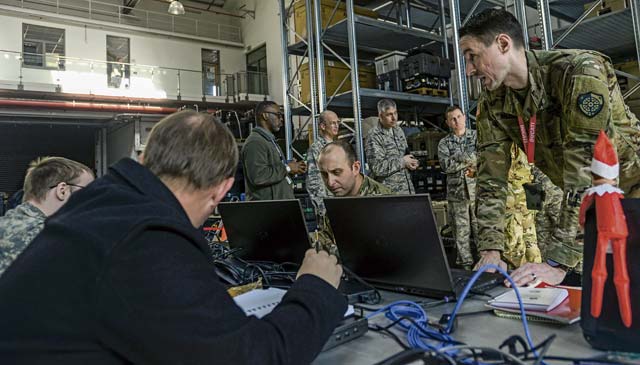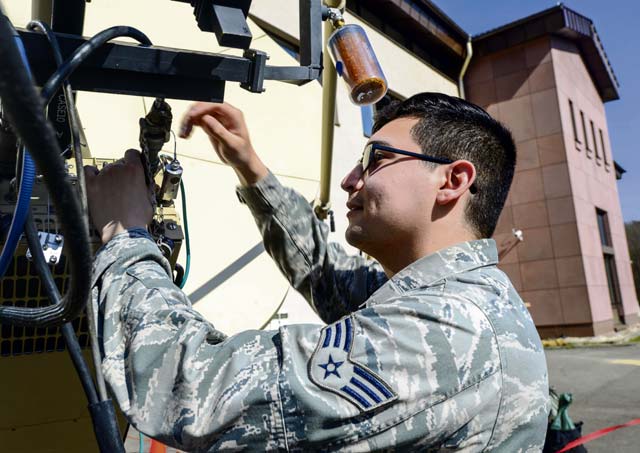
The Battle of Palmito Ranch was a late skirmish in the American Civil War that technically happened after the war was over. This most likely was the result of communications about the wars’ end not reaching the combatants.
In the numerous locations where the 435th Air Ground Operations Wing operates, it wouldn’t be hard to believe they could make a communications error. Fortunately, they have the 1st Combat Communications Squadron with tactical communications kits to ensure that doesn’t happen.
“(Our network control center) ranges from how we set up web services, to email, to backups, to the firewall,” said U.S. Air Force Senior Airman Thomas Goodnoe, 1 CBCS tactical network operations technician. “Anything that deals with the network as a whole in terms of getting communications (in a deployed location) to the people that need it.”
Tactical communications kits are mobile systems that allow the 1 CBCS operators to establish secure communications for units in deployed or otherwise austere locations.
“The cool thing about these networks is they aren’t like the (Air Force Network) domain, which we can’t fully control,” Goodnoe added. “With our deployed domains, we have the ability to create service accounts and regular admin accounts. We have full control of our whole domain, and we can manage it accordingly in terms of the mission. If a mission has certain requirements, then we’ve got to look at it and figure out, as system administrators, how we can tailor our network to the mission.”
With the versatility of their tactical communications kits, comes additional security risks.
“We mitigate our risks by running scans, making sure the enemy can’t get into our network and get certain information,” Goodnoe said.
Though the 1 CBCS takes steps to ensure the security of their network, their leaders still saw the benefit in having someone else test their systems. That’s why the 1 CBCS invited the U.S. Army Cyber Protection Brigade’s 201st Cyber Protection Team to audit their systems.
“We can attack it from a couple of fronts,” said. U.S. Army Staff Sgt. Matthew Malesinski, 201 CPT network security analyst. “One is from a network perspective. We go in and scan everything and we try to increase the security posture from a configuration standpoint to make sure the way things are talking is secure. We also approach it from a host standpoint and perform scans on the individual pieces of equipment to make sure they conform to (Security Technical Implementation Guides), the standard for implementing equipment into military networks. We make sure they try to meet those as much as possible.”
The 201 CPT calculates the vulnerability of the systems and generates a report that system administrators will be able to use to increase their security.
“I think the biggest benefit is that the operators of the equipment learn about some of the security things they should be looking for and keep in mind as they are operating the equipment,” Malesinski said. “As their network engineer team develops stuff, they pass down updates and things they know to look and ask for in order to maintain network security.”
The 1 CBCS operators weren’t the only ones to benefit from this audit.
“We came here to do a security audit of the Air Force communications kit,” Malesinski said. “That’s morphed into learning the kit because this is something we’ve never really interacted with before. Our team hasn’t really worked on tactical kits too much. We usually work on in-place networks.”
The operators involved not only got to learn about the different networks, but also how their counterparts manage and maintain the equipment and networks in preparation for working together more regularly.
“The really cool part was learning where they come from,” Goodnoe said. “The way I’m seeing cyber work now is they are trying to go more toward a joint network. We are looking to integrate the Army and Air Force. How do they operate? How do we operate? How does their equipment look compared to ours? How do we maintain our equipment? So when we do go down range, we are all on the same page when it comes to how to manage that network.”
It seems the 1 CBCS is looking good in the long fight that is cyber security.
“Security is a marathon; it’s not a sprint,” Malesinski said. “We’re not going to be able to make this kit perfect in a week. We’re going to have to come back here time and again. Security is just a long marathon until you can get to a place where you can call yourself secure, and even then you have to stay vigilant. There’s always new threats merging.”
With their dedication to ensuring the security of their networks and the help of their Army counterparts, the 1 CBCS is looking good at meeting those threats head on.



